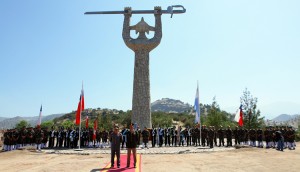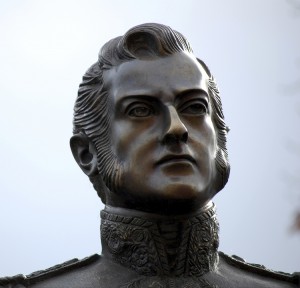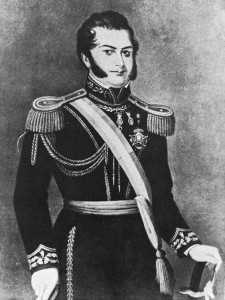200 Years: Chile’s Battle of Chacabuco
Friday, February 10th, 2017February 10, 2017
On Sunday, February 12, celebrations in Chile will mark the 200th anniversary of the Battle of Chacabuco, a key event in the history of the South American country. The battle took place on Feb. 12, 1817, near Santiago, the capital, during Chile’s struggle for independence from Spain. The Army of the Andes (made up of Chilean and Argentine rebels) defeated a Spanish-led army at Chacabuco—a rebel victory that led to Chilean independence in 1818. The battle is famous for the actions of Argentine General José de San Martín and Chilean patriot Bernardo O’Higgins, who became Chile’s first head of state.

Chilean and Argentine soldiers attend a ceremony at the Monument to the Victory of Chacabuco on Feb. 12, 2007. The monument, built in 1971, stands on the site of the former battlefield. Credit: Kiko Benítez S. (licensed under CC BY-SA 3.0)
In the mid-1500’s, Spain established a colony that became known as the Viceroyalty of Peru. By the late 1700′s, the colony included modern-day Chile, Peru, and western Bolivia. Santiago was the colony’s administrative center in Chile. In 1808, France forced Spain’s king from the throne during the Napoleonic Wars (1796-1815). With Spanish attention turned toward Europe, revolts erupted in many of Spain’s colonies, including the Viceroyalty of Peru. In 1814, Spain and its officials in America increased their efforts to reestablish authority, beginning a bloody period known as la Reconquista (the Reconquest) of Spanish America. At first, Spanish-led royalist armies put down several colonial revolts. However, rebel armies eventually got the upper hand, leading to independence for several Latin American countries.

The 1817 Battle of Chacabuco was fought in this scenic valley near Santiago, Chile. The valley is now home to far more guanacos than soldiers. Carretera Austral. Credit: © Shutterstock
In 1810, revolutionary factions calling for self-rule gained political control of Chile. Disagreements between O’Higgins and other Chilean leaders weakened the new government, however, and the Spanish royalist faction (with support from Peru) regained control of Chile in 1814. O’Higgins fled with a rebel army to neighboring Argentina, where he joined forces with San Martín. San Martín helped secure Argentine independence in 1816. He then led O’Higgins and their combined Army of the Andes into Chile in January 1817, a journey that included a dangerous and costly crossing of the Andes Mountains. More than 1,000 soldiers died from cold, disease, and hunger during the 300-mile (480-kilometer) crossing, but roughly 3,600 surviving rebels neared Santiago in early February.
The Spanish royalist army had expected the rebels to take a different route through the Andes, and most of its forces were far from Santiago. Some 1,500 troops still in the area began fortifying positions north of Santiago at Chacabuco, a ridge at the head of a wide valley. Before they could secure the high ground, however, San Martín and the Army of the Andes attacked the royalists on the morning of February 12. O’Higgins led a furious assault on the main royalist forces as a second rebel force under Argentine General Miguel Soler moved to attack from the side and the rear. Fierce fighting took place until an afternoon attack led by San Martín reinforced O’Higgins and overran the battered royalist forces as Soler blocked their retreat.
About 500 royalist troops were killed at Chacabuco, and more than 600 were captured. The Army of the Andes lost some 130 killed and wounded. The remaining Spanish and royalist troops withdrew to strongholds in southern Chile or escaped to Peru. O’Higgins took control of Chile, which declared its independence in February 1818. The royalists tried once more to retake Chile, but they were eventually defeated at the Maipo River (also spelled Maipú) near Santiago on April 5, 1818—the final major battle in Chile’s war of independence. The Army of the Andes then joined with rebels in Peru, helping win independence for that nation in 1826.




